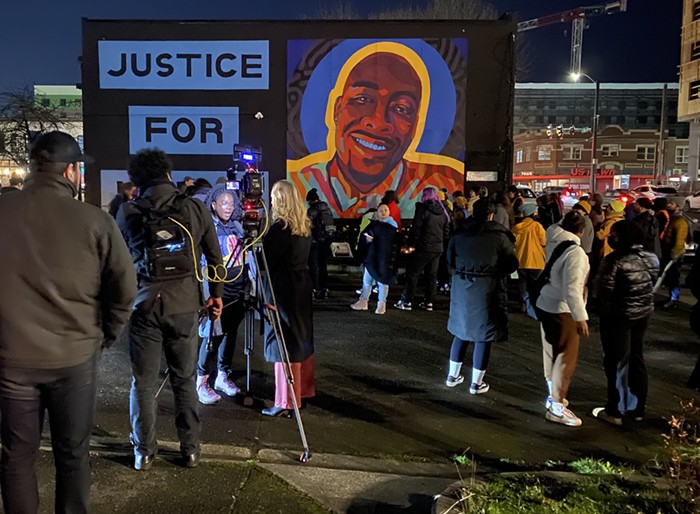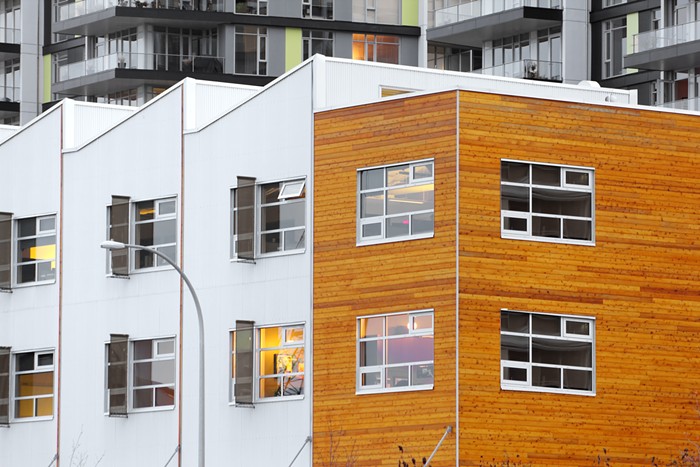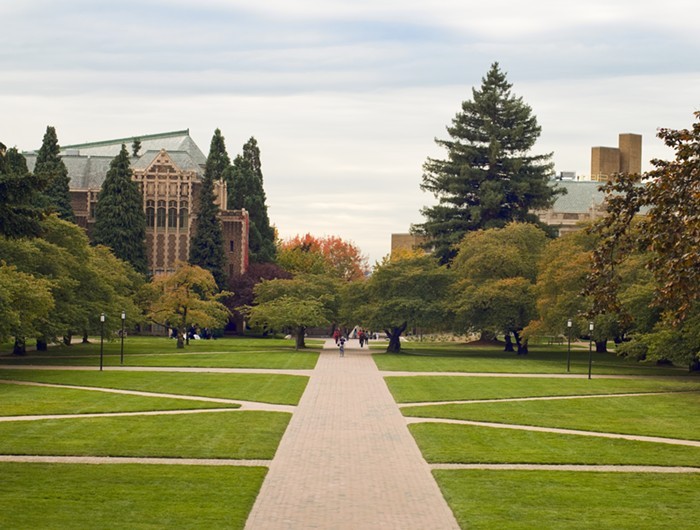
Last night, Seattle Mayor Ed Murray called for a "second look" at the design plans to replace the current King County Youth Detention Center with a social services-centered Children and Family Justice Center. (The facility, originally purported to cost $210 million, will now cost a whopping $225 million, according to Seattle City Council member Bruce Harrell and King County Council member Rob Dembowski, who recently announced they were against rebuilding the jail.) Murray's declaration comes on the eve of his seeking reelection.
On the heels of Murray's letter, King County Executive Dow Constantine, who is also up for reelection, issued his own statement, in which he called for county officials to adopt a goal of zero youth detention. As part of his plan, Constantine plans to create "peacemaking circles" between anti-youth jail activists and proponents of the planned Children and Family Justice Center. Through these series of meetings, the groups can work on "developing more housing options for youth charged with non-violent crimes, emphasizing therapeutic care, creating more robust community reviews of the detention population, devising new alternatives to detention, and helping youth take responsibility for their actions, among other strategies." Check out Constantine's full statement below:
Much has happened in our region and in our nation since the people voted to replace the aging Youth Services Center in 2012. Community conversations about policing and racial inequity helped spur important, innovative reforms in juvenile justice to keep young people out of the system and on track to healthy, productive lives. Thanks to social justice advocates, judges, and others, we have started programs like Family Intervention & Restorative Services that offer de-escalation counseling and other services to keep youth out of detention. It’s working: since the 1990’s, even as the county population rapidly grew, we have been able to reduce the average daily juvenile detention population by more than 70 percent. Last year alone, the average daily population for King County juvenile detention dropped by another 16 percent from 2015. And there’s so much more to do. We are always looking for the next innovation, the next step forward, the next partner who can help us go even further. And yet, we also confront the reality that too many teens have engaged in serious violence and caused suffering to others, and we must protect everyone in the community from harm as well.
As we pause for the city Hearing Examiner to review the Children and Family Justice Center, a process that should take at least until summer, I am taking steps to build bridges to anyone who wants better outcomes for youth. King County has achieved the lowest rate of youth incarceration in the nation. Now, in consultation with judges and members of the King County Council, I will ask that the county adopt a goal of Zero Youth Detention, with the mission of creating a community where detention for young people is no longer needed. To be successful, we must invest early in children and families, help our schools develop better ways to deal with challenging students, and offer effective support to families in crisis. Until we achieve this shared ambition, we will work to make youth detention brief, therapeutic, community-focused, and one-time.
In October, King County Superior Court conducted the first juvenile felony case to be handled through a community-driven, restorative justice process, rather than traditional prosecution. The case involved a 15-year-old facing two years imprisonment for stealing a cellphone and two pairs of Air Jordans from another teen. Instead of the standard trial and sentencing, he accepted responsibility and atoned for the crime by participating in a series of intense conversations, in family-counseling and self-reflection, and in apology to those he had harmed. In the end, he came away with things he had previously lacked in his life: a greater understanding of the feelings of others, and a second chance.
Along with King County Councilmembers and other officials and staff, I will be meeting with advocates and opponents in that same intensive process recently used by the courts to help individuals and families find new ways forward. These community Peacemaking Circles will inform our next steps: developing more housing options for youth charged with non-violent crimes, emphasizing therapeutic care, creating more robust community reviews of the detention population, devising new alternatives to detention, and helping youth take responsibility for their actions, among other strategies. I look forward to acting upon the solutions that emerge from this dialogue.
Every youth in detention represents a lost opportunity - a collective failure by the community to provide the support a child needs to arrive at kindergarten ready to thrive, to overcome the challenges that arise throughout the school years, to counteract the specific results of historical bias and entrenched racism in society. I have never talked to a local leader who disagreed with that proposition. We all want to reduce harm by making every child successful. It is, of course, easier said than done. This is a difficult issue that I and many others have spent countless hours considering, and working on. Our local leadership reflects the values of the community: we want to do better by all young people, and to protect people from violence and harm. With the right help, most teens - even those who have run into real problems - can make it through the turmoil of adolescence and go on to live fulfilling, productive lives, rather than becoming another statistic in a nation with the highest incarceration rate in the industrialized world.
We know what truly makes a positive difference for young people, and we are making those investments like never in our history. Three years after the Youth Services Center vote, the people of King County passed my Best Starts for Kids initiative, providing $65 million annually for prevention, healthy child development, and early intervention at the first sign of problems for children and youth, as well as their families and communities. Best Starts for Kids seeks to ensure every baby is born healthy, and that all children are given the full and equal opportunity to thrive, regardless of privilege or position or luck.
All people must be protected from violence. All efforts must be made to reduce harm. There are no easy answers to issues raised in juvenile justice. But with a willingness to collectively take on this challenge, we can accomplish much good, and provide better futures for our young people.
The construction permits for the youth jail, approved by the Seattle Department of Construction and Inspections in December, are currently being appealed to the city hearing examiner. A decision isn't likely to be announced until early summer, Constantine told The Stranger in a follow-up phone conversation. During this time, he said he hopes to convene these "peacekeeping circles."
"It sounds very hippy-dippy," Constantine said. "It's uncomfortable for everyone involved, but it starts with that."
Participants will have multi-hour meetings over the course of a yet-to-be-determined number of days. Conversations will be facilitated by Saroeum Phoung, who will help participants "challenge assumptions" and lead them toward "a deeper understanding and hopefully some shared agreement over how we can proceed," said Constantine. The King County executive said the list of people and organizations participating in the "peacekeeping circles" is still being developed by his office and Phoung.
When asked whether the current juvenile detention center needed to be replaced, Constantine agreed wholeheartedly. He said he is in favor of replacing the existing detention center, rather than making repairs to it, as activists have long called for. Reworking the facility's wiring and plumbing, among other repairs would cost "tens of millions more" than building the Children and Family Justice Center, he said.
"It would really be throwing good money after bad to fix a giant detention facility," said Constantine. "The current detention facility is not acceptable. It's in terrible shape, it's unhealthy, and perhaps, most of all, it's very disrespectful. It tells the young person that's there, 'You don't count.'"
For now, Constantine said, King County does require a youth jail.
"Right now in detention, there are no shoplifters, there are no truants, there aren't even domestic violence offenders, unless they're in for first degree assault, because we divert them all into Family Intervention and Restorative Services (FIRS)," he said.
Constantine continued: "There are kids who have [allegedly] killed people ... kids who've very violently assaulted people, kids who've held a gun to someone's head and stolen a car, kids who've committed rape and child molestation. The majority are very violent, recent offenders and we don't have a safe way for them to be released in the community right now. That's the dilemma."
So what do members from the anti-youth jail camp think about Constantine's announcement?
Attorney Knoll Lowney of Smith & Lowney PLLC, which represents more than 60 groups appealing the youth jail construction permit, including Ending the Prison Industrial Complex (EPIC), e-mailed us this statement:
Dow's statements sound nice, but his actions favor increased youth incarceration. Right now his lawyers are fighting aggressively to build a new youth jail designed to massively increase the jailing of kids of color. Dow needs to withdraw his permit application if he wants to show integrity on this issue and open a dialogue with the community.
In a follow-up phone conversation, Lowney said: "This facility is sized for over 150 beds," said Lowney. "So 150 kids at a time could be jailed in this facility. This is about five times higher than December's population. As much as [Constantine] likes to say 'Oh, we want to reduce [the number of beds],' why is he then fighting for 150 beds?"
Constantine's office did not immediately respond to requests for comment. We will update this post when we hear back. However, officials behind the new juvie project have long maintained that it is being designed for only 112 beds.
UPDATE, 4 P.M.: Alexa Vaughn, a public information officer for the King County Executive's office, sent us the following message in response to Lowney's statement:
The document and the editorial cited [in Lowney's statement] are outdated by a couple years. Since they were produced, the bed count was lowered to 144, and then lowered again to 112 beds in early 2015. The current design of the detention portion is flexible so that portions of it can be converted to non-detention programming in the future.
For clarification, the number of youth in a 112-bed facility would need to be much less than 112. The practical capacity of such a facility is less than 80. We have separate bed halls for the safe placement of youth of different sexes, levels of offenses and sometimes personal conflicts such as gang affiliations. We also have to be prepared for seasonal fluctuations in the juvenile detention population.
This post has been updated.


















